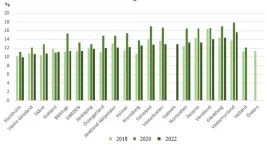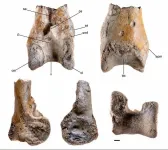(Press-News.org) When torrential rains and powerful winds hit densely populated coastal regions, whole cities can be destroyed—but governments and residents can take precautions with sufficient warning.
Many of these coastal deluges are caused by atmospheric rivers—regions of concentrated water vapor carried along on strong winds, sometimes called “rivers in the sky.” Meteorologists monitor them, but the ability to predict exactly how an atmospheric river might behave based on its underlying physics would offer more precise forecasts.
In a paper published today in Nature Communications, senior author Da Yang, assistant professor of geophysical sciences at the University of Chicago, and first author Hing Ong, a postdoctoral researcher formerly in Yang’s group and now at Argonne National Laboratory, describe a new equation they developed to better understand the processes that drive atmospheric rivers.
They hope the new framework will enhance the accuracy of atmospheric river predictions, especially for extreme weather events and in the context of a changing climate. This improved, process-level understanding also supports clearer communication of extreme weather forecast results.
A global phenomenon
Atmospheric rivers are long, narrow regions of concentrated water vapor accompanied by strong winds that carry moisture from the tropics toward the poles. They can transport as much as 15 times the amount of water that flows through the mouth of the Mississippi River, and they can bring heavy rain, snow, and strong winds. Up to half of California’s annual precipitation is brought by atmospheric rivers.
While the west coast of North America is particularly susceptible to extreme precipitation carried by atmospheric rivers—nicknamed a “Pineapple Express” when it originates around Hawaii—these rivers in the sky occur worldwide. On average, there are five in the northern midlatitudes and five in the southern midlatitudes at any given point, moving west to east. They aren’t all powerful enough to cause damaging floods and landslides; weaker systems can be beneficial, replenishing reservoirs and relieving droughts.
Atmospheric rivers are an essential element of the global climate, and understanding them will help improve the ability to forecast weather, manage water resources, and predict flood risk. Much of the existing research on atmospheric rivers involves characterization: monitoring, tracking, and rating them to help convey their hazard level. But what has been lacking is a way to determine an atmospheric river’s evolution.
“One stone, two birds”
Atmospheric rivers are monitored using a metric called integrated vapor transport (IVT), which describes the amount and velocity of water vapor moving through the atmosphere.
This metric is enough to develop tracking and monitoring algorithms, but to address fundamental questions about the evolution of atmospheric rivers, scientists need a governing equation. This is a mathematical expression that describes how a system changes based on specific rules or principles.
A governing equation would let scientists ask big-picture questions, Yang said, such as: “What provides energy to form and sustain atmospheric rivers? And why do they move eastward?”
Deriving the framework to answer these questions required the team to develop a quantity that combines the water vapor amount and the energy of strong winds into one variable: integrated vapor kinetic energy (IVKE).
The new equation is as effective and efficient as IVT at tracking and monitoring atmospheric rivers. But it has “the added benefit of being an intuitive first principle-based governing equation,” said Yang, “that can tell us what makes an atmospheric river stronger, what dissipates it, and what makes it propagate eastward—in real-time.”
The breakthrough adds physical process–level understanding to the statistical analysis of atmospheric rivers. The working title of the paper that describes this versatile framework was “One Stone, Two Birds.”
Using this new framework, Yang’s team found that atmospheric rivers mainly increase in strength because potential energy converts into kinetic energy. The rivers weaken due to condensation and turbulence and travel eastward due to the horizontal movement of kinetic energy and moisture by air currents.
Weather and a changing climate
The National Oceanic and Atmospheric Administration (NOAA), the primary center responsible for weather forecasting, researches, monitors, and publicizes information on atmospheric rivers. Yang suggested that his team’s new framework complements NOAA’s IVT-based analyses, offering real-time diagnostics that provide a stronger physical basis for forecast results. This approach boosts confidence in predictions, especially for extreme events, and aids in diagnosing model performance—ultimately guiding improvements in forecasting models.
The role of climate change in the evolution of atmospheric rivers is also a topic of interest. “We know that with climate change, the amount of water vapor is increasing,” said Yang. “Under the assumption that the circulation doesn’t change much, you may expect that the individual atmospheric river may get stronger.”
The study did not investigate that relationship, but it will be one of the team’s next steps. A new postdoctoral researcher in Yang’s lab, Aidi Zhang, will use the new framework to study how climate change impacts atmospheric rivers using vapor kinetic energy.
This research is a new area for Yang, although not so distant from his expertise, focusing on convective storms in the tropical atmosphere. Before joining UChicago, Yang lived in California for 15 years, which piqued his interest in atmospheric rivers. And “now that I live in higher latitudes,” he said, “I should pay more attention to these midlatitude storms.”
Ong, H. and Yang, D. Vapor Kinetic Energy for the Detection and Understanding of Atmospheric Rivers. Nat. Comm. (2024)
END
UChicago scientist develops paradigm to predict behavior of atmospheric rivers
Study by Asst. Prof. Da Yang provides powerful framework that sheds light on key processes driving extreme weather patterns
2024-11-04
ELSE PRESS RELEASES FROM THIS DATE:
Childhood overweight is associated with socio-economic vulnerability
2024-11-04
More children have overweight in regions with high rates of single parenthood, low education levels, low income and high child poverty. The pandemic may also have reinforced this trend. This is shown by a study conducted by researchers at Uppsala University and Region Sörmland in collaboration with Region Skåne.
“During and after the pandemic, we see a greater difference between regions in terms of children's weight. It even looks like it has exacerbated health inequalities,” explains ...
Study reveals links between many pesticides and prostate cancer
2024-11-04
Researchers have identified 22 pesticides consistently associated with the incidence of prostate cancer in the United States, with four of the pesticides also linked with prostate cancer mortality. The findings are published by Wiley online in CANCER, a peer-reviewed journal of the American Cancer Society.
To assess county-level associations of 295 pesticides with prostate cancer across counties in the United States, investigators conducted an environment-wide association study, using a lag period between exposure and prostate cancer incidence of 10–18 years to account for the slow-growing nature of most prostate cancers. The years 1997–2001 ...
LiU researchers make AlphaFold predict very large proteins
2024-11-04
The AI tool AlphaFold has been improved so that it can now predict the shape of very large and complex protein structures. Linköping University researchers have also succeeded in integrating experimental data into the tool. The results, published in Nature Communications, are a step toward more efficient development of new proteins for, among other things, medical drugs.
In all living organisms, there is a huge variety of proteins that regulate cell functions. Basically, everything that happens in the body, from controlling muscles and forming hair to transporting ...
Fossil of huge terror bird offers new information about wildlife in South America 12 million years ago
2024-11-04
**EMBARGOED UNTIL RELEASE MONDAY, NOV. 4, AT 1 A.M. ET**
Researchers including a Johns Hopkins University evolutionary biologist report they have analyzed a fossil of an extinct giant meat-eating bird — which they say could be the largest known member of its kind — providing new information about animal life in northern South America millions of years ago.
The evidence lies in the leg bone of the terror bird described in new paper published Nov. 4 in Palaeontology. The study was led by Federico J. Degrange, a terror bird ...
Scientists create a world-first 3D cell model to help develop treatments for devastating lip injuries
2024-11-04
We use our lips to talk, eat, drink, and breathe; they signal our emotions, health, and aesthetic beauty. It takes a complex structure to perform so many roles, so lip problems can be hard to repair effectively. Basic research is essential to improving these treatments, but until now, models using lip cells — which perform differently to other skin cells — have not been available. In a new study published in Frontiers in Cell and Developmental Biology, scientists report the successful immortalization of donated lip cells, ...
One-third of patients with cancer visit EDs in months before diagnosis
2024-11-04
About 1 in 3 patients diagnosed with cancer in Ontario visited an emergency department (ED) in the 90 days before diagnosis, found a new study published in CMAJ (Canadian Medical Association Journal) https://www.cmaj.ca/lookup/doi/10.1503/cmaj.240952.
In a study that included more than 650 000 patients diagnosed with cancer between 2014 and 2021 in Ontario, 35% (229 683) had visited an ED in the 90 days before diagnosis. Among patients with ED visits before their cancer diagnosis, 64% had visited once, 23% had visited twice and 13% had 3 or more visits. ...
Adolescent exam anxiety can be intensified by pressure to achieve, says academic
2024-11-04
Former teacher Professor of Education David Putwain says ‘heavy-handed’ messages around test results can fuel extreme worry among some 16 to 18-year-olds, even when others respond well to such messages.
Putwain identifies several risk factors, for example students with certain personality traits, including those who are highly self-critical, can underachieve because of severe anxiety in exams. Certain demographics also report higher exam anxiety, including female persons and those from economically deprived backgrounds.
‘Temperature checks’ to identify at-risk ...
A digital health behavior intervention to prevent childhood obesity
2024-11-03
About The Study: A health literacy-informed digital intervention improved child weight-for-length trajectory across the first 24 months of life and reduced childhood obesity at 24 months. The intervention was effective in a racially and ethnically diverse population that included groups at elevated risk for childhood obesity.
Corresponding Author: To contact the corresponding author, William J. Heerman, MD, MPH, email Bill.Heerman@vumc.org.
To access the embargoed study: Visit our For The Media website at this link https://media.jamanetwork.com/
(doi:10.1001/jama.2024.22362)
Editor’s ...
Preventing obesity in very young children could be in the palm of parents’ hands
2024-11-03
A study co-led by a Johns Hopkins Children’s Center clinician-researcher shows that adding text messaging and other electronic feedback to traditional in-clinic health counseling for parents about feeding habits, playtime and exercise prevents very young children from developing obesity and potentially lifelong obesity-related problems.
Findings from the study, which was co-led by Eliana Perrin, M.D., M.P.H., Bloomberg Distinguished Professor of Primary Care at the Johns Hopkins University Schools of Medicine, Nursing and Public Health, will be published in JAMA and presented at the Obesity Society’s “Obesity Week” in San Antonio, both on Nov. ...
Mathematical model illuminates how environment impacts life choices of salmon
2024-11-02
Tokyo, Japan – Researchers from Tokyo Metropolitan University have created a mathematical model that models how the evolutionary strategies of organisms are affected by the environment. They studied salmonid fishes which choose either to migrate to the sea then return to lay eggs or stay in the river depending on their individual features. Their model correctly predicts how the proportion choosing to migrate changes with environmental conditions, predicting how environmental change can trigger eco-evolutionary responses.
Salmonids (or salmon-like) fish are known to face a tough choice early in their lives. They can either stay where they are ...
LAST 30 PRESS RELEASES:
SIMJ announces global collaborative book project in commemoration of its 75th anniversary
Air pollution exposure and birth weight
Obstructive sleep apnea risk and mental health conditions among older adults
How talking slows eye movements behind the wheel
The Ceramic Society of Japan’s Oxoate Ceramics Research Association launches new international book project
Heart-brain connection: international study reveals the role of the vagus nerve in keeping the heart young
Researchers identify Rb1 as a predictive biomarker for a new therapeutic strategy in some breast cancers
Survey reveals ethical gaps slowing AI adoption in pediatric surgery
Stimulant ADHD medications work differently than thought
AI overestimates how smart people are, according to HSE economists
HSE researchers create genome-wide map of quadruplexes
Scientists boost cell "powerhouses" to burn more calories
Automatic label checking: The missing step in making reliable medical AI
Low daily alcohol intake linked to 50% heightened mouth cancer risk in India
American Meteorological Society announces Rick Spinrad as 2026 President-Elect
Biomass-based carbon capture spotlighted in newly released global climate webinar recording
Illuminating invisible nano pollutants: advanced bioimaging tracks the full journey of emerging nanoscale contaminants in living systems
How does age affect recovery from spinal cord injury?
Novel AI tool offers prognosis for patients with head and neck cancer
Fathers’ microplastic exposure tied to their children’s metabolic problems
Research validates laboratory model for studying high-grade serous ovarian cancer
SIR 2026 delivers transformative breakthroughs in minimally invasive medicine to improve patient care
Stem Cell Reports most downloaded papers of 2025 highlight the breadth and impact of stem cell research
Oxford-led study estimates NHS spends around 3% of its primary and secondary care budget on the health impacts of heat and cold in England
A researcher’s long quest leads to a smart composite breakthrough
Urban wild bees act as “microbial sensors” of city health.
New study finds where you live affects recovery after a hip fracture
Forecasting the impact of fully automated vehicle adoption on US road traffic injuries
Alcohol-related hospitalizations from 2016 to 2022
Semaglutide and hospitalizations in patients with obesity and established cardiovascular disease
[Press-News.org] UChicago scientist develops paradigm to predict behavior of atmospheric riversStudy by Asst. Prof. Da Yang provides powerful framework that sheds light on key processes driving extreme weather patterns



